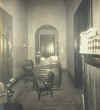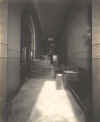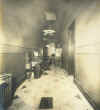Early Office Museum
Photographs of the Interior of the
First National Bank
Philadelphia, Pennsylvania
by
William H. Rau
1910
 This Early Office Museum exhibit presents original photographs detailing the inside of the First National
Bank at 315
Chestnut Street, Philadelphia, Pennsylvania, on Thanksgiving Day 1910. The
images are by William Herman Rau (1855-1920), a leading
Philadelphia photographer around the turn of the century. Further information on
William H. Rau is provided at the bottom of this web page. This Early Office Museum exhibit presents original photographs detailing the inside of the First National
Bank at 315
Chestnut Street, Philadelphia, Pennsylvania, on Thanksgiving Day 1910. The
images are by William Herman Rau (1855-1920), a leading
Philadelphia photographer around the turn of the century. Further information on
William H. Rau is provided at the bottom of this web page.
The bank occupied a two-story building on the north side of Chestnut
Street that was constructed in 1865-67. The photograph to the right, from
Moses King, King's Views of Philadelphia, 1900, shows the front of the
building. For additional vintage photographs of
the building's exterior, click here.
For further historical information about the building, visit the web site of the
Chemical
Heritage Foundation, which was in the process of gutting the interior of the
building in 2006. The offices shown in the photographs below therefore no
longer exist.
In 1910, there were eleven rooms in the bank: a large, two-story main office with an
area for customers, tellers' windows, and a large area for clerical work; four
interconnected smaller offices on the ground floor behind the main
office, each with two to six desks; two hallways that were used as offices; a conference room; an executive dining room; a staff dining room; and a
kitchen. The conference room and adjoining executive dining room were probably
on the second floor, above the four smaller offices. The staff dining room and the kitchen may have been in the
basement, because no windows are visible.
The photographs below show the building in 2006. Notice that at some time
in the past the front door was replaced by a window and the front steps were
removed. Otherwise, the facade is unchanged.


| Click Image to Enlarge |
Description
of Photographs of the First National Bank, Philadelphia, 1910 |
 |
Main office, view facing north away from the main door to
Chestnut Street. In the foreground and along the east wall (right) is the
area accessible to customers. The customer area is separated from the rest
of the room where bank employees worked by a partition with windows
identified as Paying Teller, Receiving Teller, and Foreign Collections.
The main office is two stories high.
Room 1. Image rau_01
|
 |
Main office, view facing south. The main doors to Chestnut
street are at the center rear of the photograph. The main office contains
several Wales and Burroughs adding machines. The main office is the only
room with adding machines.
Room 1. Image rau_04
|
 |
Main office, a second view facing south.
Room 1. Image rau_02
|
 |
Main office, view facing south along east wall (left). This
image shows part of the area used by bank customers. A teller's window is
identified as Foreign Collections. In the rear left corner of the
photograph is a water cooler.
Room 1. Image rau_03
|
 |
Main office, view facing north along west wall
(left). At the left rear of the room are two archways that lead to
the office in the following photograph (Room 2).
Room 1. Image rau_05
|
 |
Office located to the north of the main office, view facing
south with main office visible through the two archways at the rear of the
photograph. This room has a spiral staircase leading to the second floor,
three roll-top desks, nine 4-drawer vertical file cabinets, two large
pigeon hole filing units, and other filing units. In addition to the
electric ceiling light, there are gas lighting fixtures on the east and
west walls.
Room 2. Image rau_08
|
 |
Office in preceding photograph, view facing north. There
are wall maps of Pennsylvania and the United States. A wall calendar shows
the date to be Wednesday, November 23, 1910. At the extreme left of the
photograph, mounted on the side of a pigeon hole filing unit, is a
Planetary Pencil Pointer. The Planetary Pencil Pointer was patented in
1896 and manufactured by A. B. Dick Co. until at least 1915. This is the
earliest photograph with a mechanical pencil sharpener that has been found
by Early Office Museum staff.
Room 2. Image rau_06
|
 |
Office with six desks, one of which has a front-strike
typewriter, view facing south-east. What appear at first glance to be two
windows on the south wall are in fact doors leading to the north side of
the preceding room (Room 2). One of these doors is blocked by a desk. The
door on the left leads to another office (Room 5).
Room 3. Image rau_07
|
 |
Office in preceding photograph, view facing north-west.
Windows are along the west wall. There is a working fireplace, next to
which is a basket with coal. There is a couch. Wires hang down to provide
electricity to desk lamps and to an electric fan on the mantle next to a
candlestick telephone. Room 3. Image rau_09
|
 |
Office with two desks and a long wooden unit behind which
several clerks worked at a high counter. There is a large oriental carpet,
a smaller oriental carpet in front of a fireplace, a couch, two electric
fans, a kerosene lamp, a small safe of the type used to store ledgers, and
four candlestick phones. A wall calendar shows the month to be November
1910.
Room 4. Image rau_10
|
 |
Office in the preceding photograph, viewed from the
opposite direction. The first door on the left wall leads to the next room
(Room 5).
Room 4. Image rau_11
|
 |
Office with two desks, a fireplace, and a wall safe.
Through the door at the left rear of this photograph, one can see the
office in the preceding two photographs (Room 4). In the present office,
there is an electric fan, and there are two candlestick telephones. A wall
calendar from the Pennsylvania Salt Manufacturing Company shows the month
to be November 1910.
Room 5. Image rau_12
|
| Image
not yet available online |
Office in the preceding photograph, viewed from the
opposite direction.
Room 5. Image rau_13
|
 |
Hallway that was used as an office. There are three
oriental carpets, two desks, and four candlestick phones. A daily calendar
shows the numeral "23."
Room 6. Image rau_14
|
 |
The front half of a long hallway that was used as office
space.
Room 7. Image rau_18
|
 |
The rear half of the long hallway shown in the preceding
photograph. There is a heating grate in the floor, a cast iron radiator, a
water cooler, an electric fan, and a cast iron date stamp on a desk.
Room 7. Image rau_19
|
 |
Conference room with a fireplace as well as two cast iron
radiators. The skylight indicates the room is on the second floor. Through
the large pair of open sliding double doors at the rear one can see the
executive dining room (Room 9).
Room 8. Image rau_15
|
| Image
not yet available online |
Conference room, view from opposite direction as preceding.
Room 8. Image rau_16
|
 |
Executive dining room with seating for six. The sliding
doors to the conference room (Room 8) are closed.
Room 9. Image rau_17
|
 |
Staff dining room. The staff dining room contained three
tables, each of which seated 10 people. The door at the rear of the room
leads to the kitchen (Room 11).
Room 10. Image rau_20
|
 |
Kitchen. The staff dining room (Room 10) is visible through
the door at the rear.
Room 11. Image rau_21
|
William Herman Rau (1855-1920) was a prominent Philadelphia
photographer during the late 19th century and early 20th century. He was the
official photographer for the Pennsylvania Railroad and the Lehigh Valley
Railroad during the 1890s, for the Louisiana Purchase Exposition at St. Louis in
1904, and for the Lewis and Clark Exposition at Portland in 1905. His work
includes landscapes, railroads,
ships,
urban panoramas,
buildings
and women.
His stereographs, lantern slides, and larger format photographs are in many
museum collections and photographic archives, including the Library of Congress,
the Smithsonian's National Museum of American Art, the Museum of Modern Art in
New York City, the Maryland
State Archives, the University
of Pennsylvania Archives, the Getty
Museum, and George
Eastman House (more).
Photographs by William H. Rau at the Library of Congress are
included in the Panoramic Photographs, Robert Dennis, and Detroit Publishing
Company collections and can be located by searching at http://www.loc.gov.
Several images at the Smithsonian can be viewed by clicking on the following
links for landscapes (1,
2,
3),
ships,
and the moon.
The Smithsonian images were published in American
Photographs: The First Century, National Museum of American Art, 1996.
Rau's work is also included in American
Photography 1890 1965, Museum of Modern Art, New York, 1997.
Traveling the
Pennsylvania Railroad: The Photographs of William H. Rau was published
by the University of Pennsylvania Press in 2002. When Rau was taking his famous
railroad photographs in the 1890s, a newspaper account stated: "The Eastman
Kodak Company has just completed the largest view camera in the world.... This
camera was made for W. H. Rau of Philadelphia, the famous landscape photographer
of the Pennsylvania railroad company, and is capable of taking a plate
thirty-six inches long." (Democrat & Chronicle, Rochester, NY,
Dec. 15, 1893)
The George Eastman House photographic collection includes
lantern slides showing the private
offices of the Adjutant
General and Treasurer
at the Pennsylvania State Capitol at Harrisburg
taken in 1906 by William H. Rau. These images are similar to ones of the smaller
offices at the First National Bank exhibited above.
Return to Top of this Page
|
 This Early Office Museum exhibit presents original photographs detailing the inside of the First National
Bank at 315
Chestnut Street, Philadelphia, Pennsylvania, on Thanksgiving Day 1910. The
images are by William Herman Rau (1855-1920), a leading
Philadelphia photographer around the turn of the century. Further information on
William H. Rau is provided at the bottom of this web page.
This Early Office Museum exhibit presents original photographs detailing the inside of the First National
Bank at 315
Chestnut Street, Philadelphia, Pennsylvania, on Thanksgiving Day 1910. The
images are by William Herman Rau (1855-1920), a leading
Philadelphia photographer around the turn of the century. Further information on
William H. Rau is provided at the bottom of this web page.



















